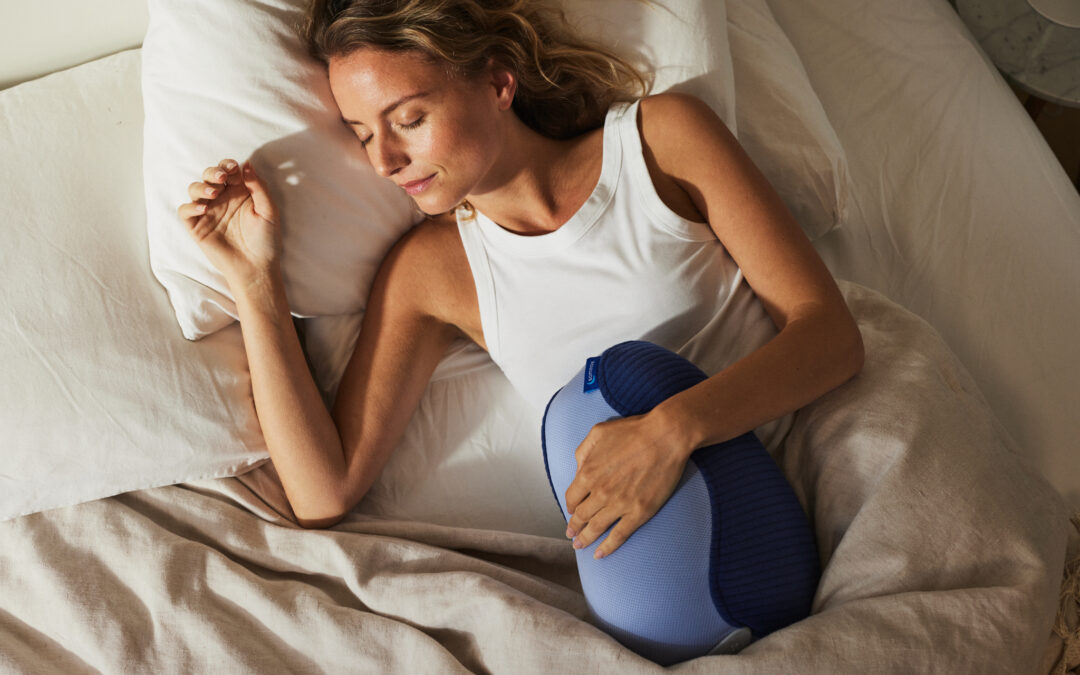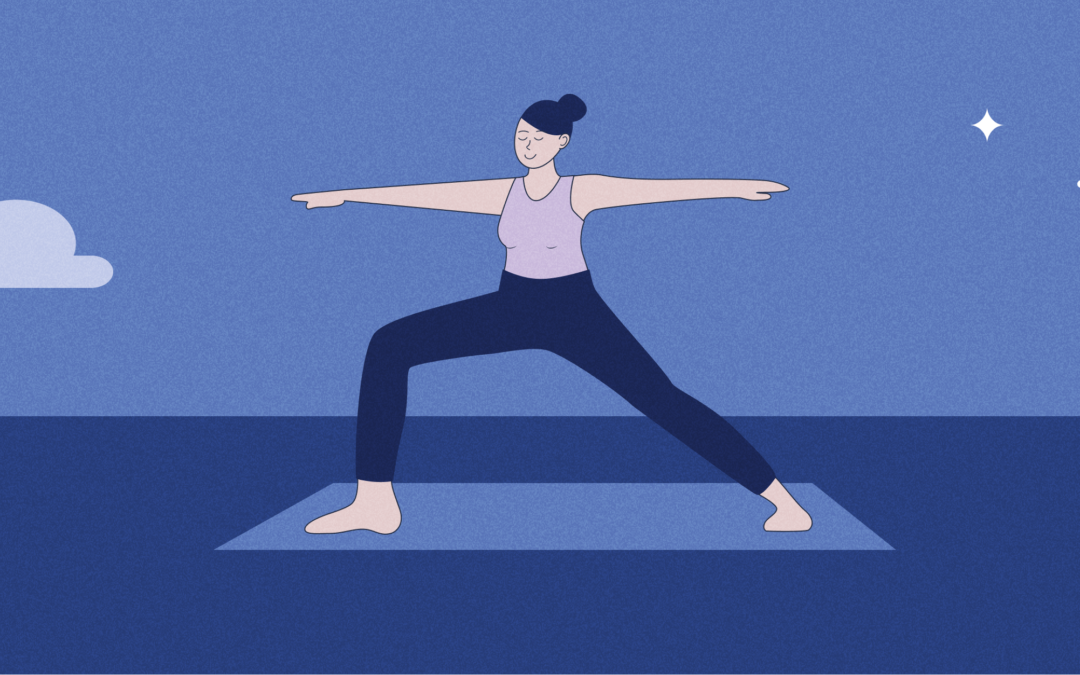
by Baginda Tirtadji | Friday, July 29, 2022 | Breathing, Sleep
When done for just five minutes a day, deep breathing exercises can lower blood pressure, boost vascular health, and sharply reduce your chances of developing cardiovascular disease. It almost sounds like an infomercial, but this is no gimmick.
Extensive research shows that diaphragmatic breathing (aka abdominal breathing) has serious power when it comes to lowering blood pressure and has the potential to improve the health of billions across the globe.
This article will explore how diaphragmatic breathing can naturally lower blood pressure, as well as share six simple yet highly effective breathing exercises you can start using today.
What Is High Blood Pressure?
More than 30 percent of the adult population worldwide, and nearly half of the U.S. population, experience a medical condition called high blood pressure, also known as hypertension.[*][*] The term “blood pressure” refers to the force of the blood pushing against the walls of the arteries. When someone is diagnosed with high blood pressure, it means the force of the blood on the veins is too high, specifically above 130/80 mmHg.
High blood pressure forces the heart to work harder and weakens the inside of the arteries, which can lead to life-threatening medical conditions like heart attacks and strokes.
Several factors can contribute to high blood pressure, including smoking, a salty diet, obesity, stress, excessive alcohol consumption, and genetics. Fortunately, you can bring your blood pressure numbers down with lifestyle changes: exercising, limiting salt intake, maintaining a healthy diet, avoiding tobacco smoke, and practicing diaphragmatic breathing.
How Does Diaphragmatic Breathing Affect Blood Pressure?
To understand how breathing affects blood pressure, let’s examine what happens in the body when you take deep, diaphragmatic breaths.[*]
- You reduce the activity of your sympathetic nervous system, which is responsible for the “fight or flight” reflex.
- You increase the activity of the parasympathetic nervous system, which is responsible for the opposite reflex—“rest and digest.” When this happens, your heart rate decreases, your blood vessels dilate, and your breathing rate slows.
- You increase blood flow to your body’s tissues, which reduces resistance in your blood vessels.
- Your diaphragm moves up and down, facilitating blood flow towards the heart.
The combination of the above bodily processes naturally lowers blood pressure. This isn’t mere conjecture either—numerous clinical research studies have documented the beneficial effects of slow, deep breathing on blood pressure.[*][*][*][*]
Diaphragmatic Breathing Exercises for Lowering Blood Pressure
The following breathing exercises for high blood pressure can be done virtually any time, anywhere. Aim to practice diaphragmatic breathing for five to 20 minutes a day.
30-Second Breathing
According to a study involving 20,000 Japanese individuals, taking six deep breaths within 30 seconds can significantly reduce systolic blood pressure.[*] Systolic blood pressure is the top number in a blood pressure reading. It measures the force produced by the heart when it pumps blood through the body.
How to practice:
- Set a timer for 30 seconds.
- Take six deep breaths, in through your nose and out through your mouth.
- Repeat as needed throughout your day.
Equal Breathing
Equal breathing, also known as box breathing, is a foundational deep breathing practice and a perfect exercise to begin with. As the name suggests, this technique focuses on taking steady inhalations and exhalations of equal duration.
How to practice:
- Exhale slowly, releasing all the air from your lungs.
- Breathe in through your nose as you slowly count to four in your head.
- Hold your breath for a count of four.
- Exhale for a count of four.
- Hold your breath for a count of four.
- Repeat steps 2-5 for four rounds, or until you feel relaxed.
Alternate Nostril Breathing
Alternate nostril breathing is a yogic breath control practice that entails alternating breaths between the two nostrils. In a study of people with hypertension, those who practiced alternate nostril breathing 20 minutes a day for five days experienced a marked reduction in systolic blood pressure and diastolic blood pressure—the bottom number of a blood pressure reading that reflects the pressure in the arteries when the heart rests between beats. The study participants also experienced a reduction in heart rate.[*]
How to practice:
- Raise your hand to your nose, as if you were going to pinch your nose shut with your thumb and pointer fingers.
- Exhale fully and then close your right nostril with your thumb.
- Inhale through your left nostril.
- Open your right nostril and exhale through it while closing your left nostril with your pointer finger.
- Continue this rotation for five minutes.
Diaphragmatic Breathing with Somnox
If you feel like you could use some extra guidance in practicing diaphragmatic breathing, look no further than Somnox 2. Using robotic technology, this science-backed device expands and deflates as if it’s taking deep, diaphragmatic belly breaths. Somnox can be used to lower stress and induce relaxation any time of day, whether on your lunch break or before sleep.
By simply cradling Somnox, you’ll unconsciously adopt the same slower-paced breathing rhythm. This reduces the activity of the sympathetic nervous system while increasing the activity of the parasympathetic nervous system.
How to use:
- Hold Somnox 2 and turn it on. Within minutes, you’ll subconsciously adopt its calm breathing pattern.
- Smart sensors respond to your breathing in real-time, matching your rhythm and gradually adjusting it to the ideal rate.
- Feel your nerves relax and tension release.
- If you’re using it for sleep, continue deeply breathing until you fall asleep. With the help of Somnox 2, you’re sure to fall asleep quickly, stay asleep, and wake up feeling rested.
Take our online sleeptest to determine if Somnox is right for you.
Breath Focus
This diaphragmatic breathing technique uses focus words, phrases, or images to induce relaxation. You can choose a focus image, word, or phrase that makes you feel relaxed or happy, or one that is simply neutral.
Example words include “peace,” “calm,” or “relax.” You can also say a short phrase in your mind with each inhale and exhale. For example, “I breathe in calm” as you breathe in, and “I breathe out tension” as you exhale. Focus images may be something like a pristine, white sand beach or a calm lake.
How to practice:
- Practice diaphragmatic breathing for a couple of minutes, breathing deep into your belly.
- Begin the practice of breath focus by combining this deep breathing with your chosen word, phrase, or image. To do this, repeat your chosen word or phrase in your mind (or visualize your chosen image) while you continue to inhale and exhale.
- Continue for a few minutes or until you feel relaxed.
Use Your Breath to Lower Your Blood Pressure
Diaphragmatic breathing is the quickest way to lower blood pressure without medications. Even more impressive is that it can lower blood pressure to a similar degree as blood pressure-reducing medications.[*]
Diaphragmatic breathing is especially beneficial if your high blood pressure is caused by stress or anxiety, but it will help regulate your blood pressure regardless of the cause.
If you’re concerned about high blood pressure or the overall quality of your health, incorporate these simple breathing exercises into your routine starting today. You’re sure to be pleasantly surprised by how something so simple and natural can significantly impact your health and well-being.

by Luciënne Lieshout | Friday, July 8, 2022 | Breathing, Research
If you’ve been thinking about beginning meditating—or you’ve tried meditation before but weren’t sure if it did anything for you—then this blog post is for you. Read on to learn how to begin a solid meditation practice.
Who should meditate?
Whether you consider yourself a nervous wreck or a total zen master, you can benefit from meditation. When practiced over time, meditation can actually change your brain for the better.
Meditation can be tremendously beneficial for mental conditions like depression and anxiety. It can also help manage physical conditions like chronic pain. But it’s also just an excellent tool for managing everyday stress. So unless you live a life free from problems, meditation is for you!
What is the goal of meditation?
The goal of meditation is to achieve a state of tranquility. This is a state where your thoughts can exist without judgment. Emotions are the result of the way we judge our thoughts. These emotions, when negative, can lead to restlessness or stress.
By accepting your thoughts as they are, you can ease feelings of restlessness, anxiety, and stress.
The role of the breath in meditation
Breathing is the crux of meditation. By consciously working on calm breathing, tension melts away from your body. Somnox can help you work on your breathing. All you need to do is put your hands on Somnox (or hold it close to you) to follow its breathing. Through the Somnox app, you can fully customize your breathing experience.
5 steps to start meditating
1. Make time for meditation
It is often difficult to find time for meditation. “I don’t have time” becomes an easy excuse to skip sessions or to never start in the first place. That’s why it’s important to plan in advance when you will meditate and for how long. Ten minutes is all you need to start!
By putting meditation on your schedule and making an appointment with yourself, it is often easier to stick to it. If you don’t like to plan ahead or don’t think you can commit to sticking to a plan—don’t let that stop you. You can always meditate as needed when you experience stress or negative emotions.
2. Find a comfortable position
Choose a position that feels comfortable to you. Here are some common positions people take when meditating.
- Sit in a chair
- Sit on the floor with legs crossed
- Sit on a cushion on the floor
- Sit against a wall with your legs straight
- Sit on your heels with knees bent
- Lying down*
*Although it’s usually recommended that you meditate while sitting up so you can remain alert, if this is too difficult for you or you’re not feeling well, you can meditate lying down. Just make sure you can stay alert in this position.
Once you’ve found your ideal meditation position, relax your body and rest your hands on your Somnox so you can feel it breathing.
3. Breathe with Somnox
Breathing is central to meditation. The breath acts both as a focal point for the mind and is also used to calm the body. By concentrating on the rhythm of your breathing, you have a place to return to again and again when your mind wanders.
By actively breathing with Somnox, you are consciously slowing down your breath, relaxing your body and mind. Focus your attention on the flow of air in and out and your belly rising and falling. If you want to learn more about how Somnox works, click here!
4. Let your thoughts move through you
If you’ve ever tried meditating before, you may have been asked to “clear your mind.” Unless you’re a master meditator, achieving a clear mind for an entire meditation session is nearly impossible. Thoughts will pop up as you focus on your breath. Don’t let these thoughts discourage you from meditating—this is part of the process.
Allow these thoughts to move through you without judging them. If you experience a distracting thought or feeling, acknowledge it, but don’t give it power by dwelling on it. Simply return your focus to the breath. Each time your mind strays, acknowledge your thought or feeling, then return to the breath again and again. This is how you practice meditation.
5. Practice!
Although you will feel peaceful after meditating, it can seem a bit challenging at first. But the more you do it, the easier it will become, and the more you’ll benefit from it. So grab your Somnox, get into a comfortable position, and start meditating today!
Still not sure if Somnox is for you? Take the sleep test to find out!
Sources
Dixon, T. (2017, August 20). Key Studies: The effects of mindfulness and meditation on the brain (Desbordes et al. 2012, and Lazar et al. 2005). IB Psychology. https://www.themantic-education.com/ibpsych/2017/08/21/key-studies-the-effects-of-mindfulness-and-meditation-on-the-brain-desbordes-et-al-2012-and-lazar-et-al-2005/
Powell, A. (2018, August 27). Harvard researchers study how mindfulness may change the brain in depressed patients. Harvard Gazette. https://news.harvard.edu/gazette/story/2018/04/harvard-researchers-study-how-mindfulness-may-change-the-brain-in-depressed-patients/

by Baginda Tirtadji | Friday, July 1, 2022 | Breathing, Research
Since we launched Somnox, we’ve been dedicated to gathering feedback to see how it has improved people’s sleep. Recently, we sent out an Impact Survey to hear first-hand from our Dutch customers why they value Somnox and how they are interacting with it.
And the results are in! Our sleep companion is making a huge impact, with users reporting more relaxation and better sleep. But we discovered sleep is not the only thing people use Somnox for—people are using Somnox in creative ways.
Read on to learn more about how Somnox is changing lives and what it can do for you!
How is Somnox helping?
We’re happy to report that Somnox is helping the vast majority of users with at least one aspect of their wellness. The results of our survey are based on the voluntary responses of 483 current Dutch Somnox users. Of this group, 48% have a Somnox 2, and 52% a Somnox 1.
Of Somnox 2 respondents, 94% reported that Somnox helps them sleep better (85% for non-daily users), 85% said Somnox helps them reduce stress, and 71% say they feel more energetic. Wow!
What does Somnox help with?
Sleep issues among Somnox run the gamut. Some people have trouble falling asleep, while others wake up in the middle of the night and can’t get back to sleep. Others wake up too early. Others just want to relax during the day to help manage their stress levels.
On average, respondents report that their Somnox helps with the following things:
- 70% – helps them relax
- 56% – fall asleep faster
- 49% – help fall back asleep in the middle of the night
- 25% – helps them sleep through the night
How attached are users to their Somnox?
In our survey, we asked users how they would feel if they could no longer use their Somnox. Of users, 80% said they would be disappointed if they could no longer use Somnox. This effect was strongest in the 65+ group.
How often are people using Somnox?
Of all active Somnox 2 users, 78% indicate they use the Somnox daily, while about 20% reported they used the product once a week or so. Older users were more likely to use their Somnox daily or even multiple times a day.
We believe that increased usage in older adults is most likely due to the fact that older people wake up more often during the middle of the night.
When are people using Somnox?
Somnox is a sleep companion that is predominantly used in bed before sleep as well as during the night. When asked what part of the day people are using Somnox, more than 93% said they use Somnox in bed before sleep. Interestingly, 64% say they use their Somnox in the middle of the night as well.
For people under 50, especially among the 18-24 group, we saw relatively more use during the afternoon and evening. This could be because mindfulness practices, such as breathing exercises, are more popular with younger people.
Some of our customers have mentioned using Somnox during the day for breathing to manage stress and anxiety. We think this is a great idea, and we are glad to hear people are using Somnox in creative ways!
What feedback are we receiving from customers?
We are receiving very positive feedback from many of our users and are so happy to hear their comments.
Here’s what Somnox users are saying:
“So glad you came up with the Somnox!”
“Very nice product! It’s also good for relaxation exercises.”
“I am very happy with Somnox. Awesome invention and product for everyone, everywhere, all day long.”
Who is using Somnox?
We noticed some important differences between age and gender.
We discovered that 79% of Somnox users are women. This makes sense because women are twice as likely to experience insomnia. Hormonal changes throughout a woman’s life—such as during pregnancy, menopause, or PMS—can cause sleep problems.
And while gender roles are changing, women are also more likely to have an overlapping caregiver and work duties, which results in less time to unwind and sleep.
In terms of age, we found out that 65% of our users are over 50. This is again in line with sleep statistics. As we age, our sleep patterns change—we sleep less overall and have more trouble falling and staying asleep.
What do people like about the Somnox app?
On the Somnox app, a couple of things that users can adjust are breathing intensity and breathing ratio (out-breath to in-breath). Breathing intensity was the most valued feature, with breathing ratio being the second most valued feature.
Somnox Sense, which is a feature that allows the Somnox to sync its breathing with yours, is the third most valued feature of the app.
Our older users love the starting rate and intensity features, while younger users value Somnox Sense and music options.
Impact results summary
From the results of our survey, we are thrilled to see an overwhelmingly positive response to Somnox. People are using it to help them get a better night’s sleep, feel more energetic, feel more relaxed, and reduce stress levels.
We love to hear that Somnox is making such a positive impact, helping our customers to lead healthier, happier lives.
If you’re curious about how Somnox might help you achieve better sleep or just want to give it a try for yourself, order your very own Somnox today. We offer a risk-free 30-day trial, so you can see for yourself how this little companion can make a big difference in your life.
Try Somnox for 30 days.
Sources
Somnox Impact Survey (2022)
Aging changes in sleep. (n.d.). Medline Plus. Retrieved June 21, 2022, from https://medlineplus.gov/ency/article/004018.htm
Muller, A. (2018, October 2). Why Women Are Twice As Likely To Have Insomnia Than Men. Michigan Health. https://healthblog.uofmhealth.org/health-management/3-reasons-women-are-more-likely-to-have-insomnia#:%7E:text=D.&text=No%20matter%20how%20tired%20you,and%20stay%20asleep%20%E2%80%94%20as%20men

by Luciënne Lieshout | Monday, June 20, 2022 | Breathing, Research
The summer solstice is just around the corner and with it comes hot, sticky nights. Many people find it difficult to get a good night’s sleep during the summer months. Luckily, we’ve got some tips and tricks to help you stay cool and get a good night’s sleep. Keep reading to learn how to sleep when it’s hot!
Is Samantha’s story familiar?
Samantha loves summertime but she doesn’t love summer nights. It gets really humid where she lives, so it stays warm even when the sun has gone to bed. Even though she only sleeps with a light sheet, she finds herself tossing and turning, taking her much longer to get to bed than usual.
She doesn’t want to spend a fortune on air conditioning, so she opens the windows and turns on her ceiling fan, and even brings an extra fan into her room. But she still can’t seem to get cool!
Sound familiar? So what’s the deal—why is it harder for us to sleep during warm summer nights?
Why do we sleep worse when it’s hot?
There are a few reasons why hot weather can make it difficult to sleep. First, long summer days and exposure to light later in the day mean our bodies begin producing melatonin later. Melatonin is the hormone that makes us feel sleepy, so when it’s produced later in the day, we can have trouble falling asleep.
Another reason hot weather can cause us to sleep worse is due to body temperature. Humans and other mammals usually have a lower core body temperature right before and during sleep. These changes in body temperature are actually regulated by our circadian rhythm. Our circadian rhythm controls our internal clock which regulates our sleep/wake cycle. So when it’s hot at night, our bodies have a harder time regulating their temperature.
Okay, so how do I stay cool at night?
There are a few things you can do to lower your body temperature and make it easier to sleep during hot weather.
1) Close your blinds or curtains while the sun is out
Make sure to keep your blinds shut during the day. This will help to keep your room cooler—and you more comfortable—when the sun goes down. If you have blackout curtains, even better! These will block out all light and have insulative properties to further block heat from your bedroom.
2) Control the temperature with fans or evaporative coolers
If you’re not looking to spend a fortune this summer on your energy bill cranking your AC, you can get creative with fans and evaporative coolers. An evaporative cooler (aka swamp cooler) is a very affordable option for cooling a small space. You can buy a portable unit that doesn’t cost much and doesn’t use much electricity. This should help keep the temperature down in your room. You can also turn your ceiling fan on so that it circulates counterclockwise for a wind-chill effect.
3) Assess your bedding situation
Hopefully, you’ve remembered to put your fleece and heavy down comforters away and changed over to summer fabrics. Cotton and linen are affordable options while silk is cooling and helps regulate body temperature. If you don’t have light bedding, now’s the time to invest. You might also want to consider a cooling mattress topper or cooling pillow to help you sleep when it’s hot.
4) Eat light, small meals in the evening
Meals that are heavy in carbs and fats can make you feel sluggish and can cause indigestion, making it harder to sleep. They also take more energy to digest, so this can cause your body to heat up. Spices are also best avoided in the evening as they can cause nighttime hot flashes. Instead, focus on lean proteins and vegetables.
5) Relax your body with the help of Somnox
Summer heat can keep your body feeling uncomfortable when you’re trying to sleep. But stress and anxiety are the main culprits behind sleeplessness. If you can find a way to relax your body and mind before bedtime, you’ll be well on your way to enjoying deep and restful sleep.
That’s where Somnox can help. Your Somnox sleep companion offers a sense of security while relaxing you through the automatic slowing of your breath. You’ll forget the heat and drift off to sleep in no time!
In Conclusion
While we can’t change the weather, there are plenty of things we can do to make our summers more comfortable. From cooling down our bedrooms with fans and evaporative coolers to eating lighter meals in the evening, these tips should help you beat the heat this summer.
And if you still find yourself struggling to get a good night’s sleep, consider investing in a Somnox. This unique sleep companion helps relax your body and mind so that you can drift off faster and easier. So what are you waiting for? Take our quiz to see if Somnox is right for you!
Sources
Neustein, M. R. B. S., MD, & Okoye, W. B. A. (2021, November 12). Why Do You Get Hot When You Sleep? Sleep.Org. https://www.sleep.org/how-sleep-works/does-your-body-temperature-change-while-you-sleep/
Sievers, M. (2021, June 30). How to Stay Cool at Night: 25 Tips. Casper Blog. https://casper.com/blog/how-to-stay-cool-at-night/
Vondrasová D, Hájek I, Illnerová H. Exposure to long summer days affects the human melatonin and cortisol rhythms. Brain Res. 1997 Jun 6;759(1):166-70. doi: 10.1016/s0006-8993(97)00358-2. PMID: 9219878.

by Baginda Tirtadji | Tuesday, May 10, 2022 | Breathing, Research
Sleep is important for a child’s physical growth and cognitive development. However, around 25-50% of young children suffer from some kind of sleep problem [1]. Bad sleep has an impact on the child’s development and daily life, but can also influence the sleep and stress levels of the parents.
Michael Gradisar is a clinical psychologist, sleep researcher, and Head of Sleep Science at Sleep Cycle AB. He specializes in sleep problems in children and young adults.
“I fell in love with the whole concept of sleep, because it’s something that we all do and can relate to.”
How did you become a sleep researcher?
“My goal was to become a clinical psychologist, and I had the opportunity to work at an insomnia clinic for children. I realized that there was not much research on sleep in children yet, so that fascinated me. I could build treatments, and test it in clinical practice. It’s great to do research that’s interesting, but also helps people at the same time.”
What sleep problems occur in children?
“Children can get really anxious at night which prevents them from falling asleep. They believe that once they go to sleep, they can be attacked or taken away. Worrying about a threat of someone breaking in, makes them very alert to their surroundings at night.”
“Children can get really anxious at night which prevents them from falling asleep”
How does this impact their parents?
“Children can experience separation anxiety from their parents at night. Some children sleep in their parents’ bed or next to them on a mattress and others need their parents to be with them until they fall asleep. Parents are likely to think: “How can I get my bedroom back? My child is way too old to sleep next to us.”
“Children can experience separation anxiety from their parents at night”
How do you treat insomnia in children?
“The treatment of insomnia in children is similar to the treatment in adults, but we focus more on treating separation anxiety and building up sleepiness during the day. If a child feels more sleepy at night, after a while we see that children don’t care about burglars anymore, and just want to go to sleep. We also do relaxation training, which is part of cognitive behavior therapy for insomnia.”
How can breathing with Somnox help?
“Children can follow the breathing rhythm which helps them calm down and prepare for bed. Instead of worrying about a burglar coming in that’s going to harm them, they just focus on their breath. Somnox can also provide children with a sense of security, similar to sleeping with a pet in bed. Children refocus their attention away from potential fears to the Somnox Breathe and Sleep Robot.”
“Somnox can provide children a sense of security, similar to sleeping with a pet”
“Children refocus their attention away from potential fears to the Somnox Breathe and Sleep Robot”
What’s the advantage of Somnox over a teddy bear?
“There is a difference between a teddy bear and a Somox Breathe and Sleep Robot. If a child doesn’t have his or her teddy, he or she cannot fall asleep. Somnox can teach a child how to deal with a bad night by breathing exercises. So even if a child doesn’t have Somnox, they can use slow breathing to calm down.”
“Somnox can teach a child how to deal with a bad night by breathing exercises”
How can parents help their children with their sleep?
“It’s important for parents to understand that their child is anxious. Rather than telling them that no one is coming into their bedroom, it’s better to use questions and logic. With practice, the child can come to the conclusion himself or herself that nothing is going to happen.”
How much sleep do children need?
Michael: “Children need just enough sleep to function and feel okay the next day. Parents should realize that all kids are different, so they need to experiment and see what bedtime works best for their child.”
Overall, what’s your best sleep tip?
Sleep loves structure. Having structure in your life, for example, having regularity in your bed times, what you do leading up to bedtime and what you do when you wake up in the morning, is the best thing for good sleep.
“Having structure in your life is the best thing for good sleep”
For anyone looking to improve their sleep, Somnox 2 is your science-backed sleep companion that guides you towards slow-paced breathing that helps you fall asleep faster, worry less and wake up rested. 70% of our users improved their sleep quality within 4 weeks. Interested? See how it works.

by | Friday, April 29, 2022 | Breathing, Research
When practicing yoga, it’s easy to get caught up in perfecting every pose—so much so that you forget to breathe! While poses (known as asanas) are certainly a cornerstone of yoga, breath is the foundation of the entire practice. It supports your movement and acts as a guide, drawing you back to the present moment.
The practice of breath regulation during yoga is called pranayama. In Sanskrit, “prana” means life energy and “yama” means control. Pranayama involves consciously adopting specific breathing patterns to support your yoga practice.
In this article, we’ll explore why breathing is such an essential part of yoga and share six yogic breathing exercises that can support you on or off the mat.
The Importance of Diaphragmatic Breathing
Yoga translates to “union” or “yoke” in English—it’s the union (or yoking) of mind and body. During a yoga session, your breath acts as a bridge between your mind and body, uniting the two.
Each breath helps you achieve your poses, release tension, focus on the present moment, and form a deeper mind-body connection.
Yogic breathing techniques are not only useful on the mat, but they can also benefit your physical and mental well-being when going about your daily activities. Research shows that diaphragmatic breathing can reduce stress, soothe anxiety, improve focus, and support important physiological processes, such as circulation and digestion.[*][*]
These positive benefits occur because lengthening exhalation relative to inhalation increases the activity of your parasympathetic nervous system (which controls your rest-and-digest response) while decreasing the activity of your sympathetic nervous system (which controls your fight-or-flight response).
Breathing Exercises for Yoga
Whether you’re looking to incorporate diaphragmatic breathing on or off the mat, here are six transformative yoga breathing techniques to try.
1. Basic Breath Awareness
Basic breath awareness is the foundation of all yogic breathing. It’s about becoming aware of your breath and noticing its characteristics. This exercise requires zero breath manipulation on your part.
How to practice:
- Breathe in and out naturally without trying to control it.
- Bring your attention to your breath.
- Observe how it sounds, feels, and behaves.
- Practice this for 3-5 minutes, or longer if you’d like.
2. Ujjayi Pranayama (Ocean Breath)
Known for producing a sound resembling ocean waves, this breathing exercise is used to stimulate the relaxation response, support movement from one posture to the next, and increase oxygen consumption.
How to practice:
- Inhale deeply through your nose.
- Exhale through your mouth while slightly contracting the back of your throat. Imagine you are trying to fog up a mirror in front of you.
- Once you’re comfortable with the exhale, apply the same throat contraction to your inhales.
- When you’re able to control the throat on both the inhale and exhale, close the mouth and begin breathing only through the nose. Continue applying the same constriction to the back of your throat.
- Use this technique throughout your yoga practice or whenever you need some soothing.
3. Nadi Shodhana Pranayama (Alternate-Nostril Breathing)
In Sanskrit, “Nadi” means “nerves” and “Shodhana” means “cleaning” or “purification.” Living up to its name, Nadi Shodhana Pranayama, also known as alternate nostril breathing, has been shown to be a powerful technique for balancing the autonomic nervous system.[*]
How to practice:
- Raise your hand to your nose as if you were going to pinch your nose shut with your thumb and pointer fingers.
- Exhale fully and then close your right nostril with your thumb.
- Inhale through your left nostril.
- Open your right nostril and exhale through it while closing your left nostril with your pointer finger.
- Continue this rotation for five minutes.
4. Kumbhaka Pranayama (Breath Retention)
Defined by short periods of holding your breath, this exercise is highly effective for reducing the activity of the sympathetic nervous system.
How to practice:
- Breathe in through your nose for five seconds.
- Hold the air inside your lungs for ten seconds.
- Exhale slowly through your mouth.
- Repeat this process 4-5 times, or as long as you’d like.
5. Bhramari Pranayama (Bumblebee Breath)
This breathing technique is named after a type of black Indian bee due to the bee-like buzzing sound produced during the exhale. It’s an effective tool for getting stress, anxiety, agitation, and tension to buzz off.
How to practice:
- Keeping your lips tightly sealed, inhale through your nose.
- Exhale through your nose, making the sound of the letter M (a humming sound).
- Continue the sound until you need to inhale.
- Repeat as long as needed.
6. Diaphragmatic Breathing with Somnox
If you feel like you could use some extra guidance in establishing a relaxing, yoga-inspired breathing pattern, look no further than Somnox 2. Through robotic technology, this science-backed device expands and deflates as if it’s taking deep, diaphragmatic belly breaths.
By simply holding Somnox, you’ll unconsciously adopt the same slower-paced breathing rhythm. This stimulates the parasympathetic nervous system, which relaxes your nerves and helps you feel more at ease.
Somnox can be used to induce relaxation at any time, whether during the day or before bed.
How to use:
- Hold Somnox 2 and turn it on. Within minutes, you’ll subconsciously adopt its calm breathing pattern.
- Smart sensors respond to your breathing in real-time, matching your rhythm and gradually adjusting it to the ideal rate.
- Feel your nerves relax and tension release.
- If you’re using it for sleep, continue deeply breathing until you fall asleep. With the help of Somnox 2, you’re sure to fall asleep quickly, stay asleep, and wake up feeling rested.
Take our online sleep test to determine if Somnox is right for you.
A Final Word on Breathing Exercises for Yoga
Apart from sustaining life, breathing is a powerful tool for regulating your autonomic nervous system. Your breathing pattern can influence how you feel and perform, both mentally and physically.
Even better? Your breath is always available to you, no matter what you’re doing or where you are. Whether you practice these breathing exercises on your yoga mat, in traffic, or before sleep, you’re sure to notice the tremendous impact they have on your well-being.






Recent Comments